Charles E W Bean, Diaries, AWM38 3DRL 606/282/1 - 1918 - 1940 - Part 1
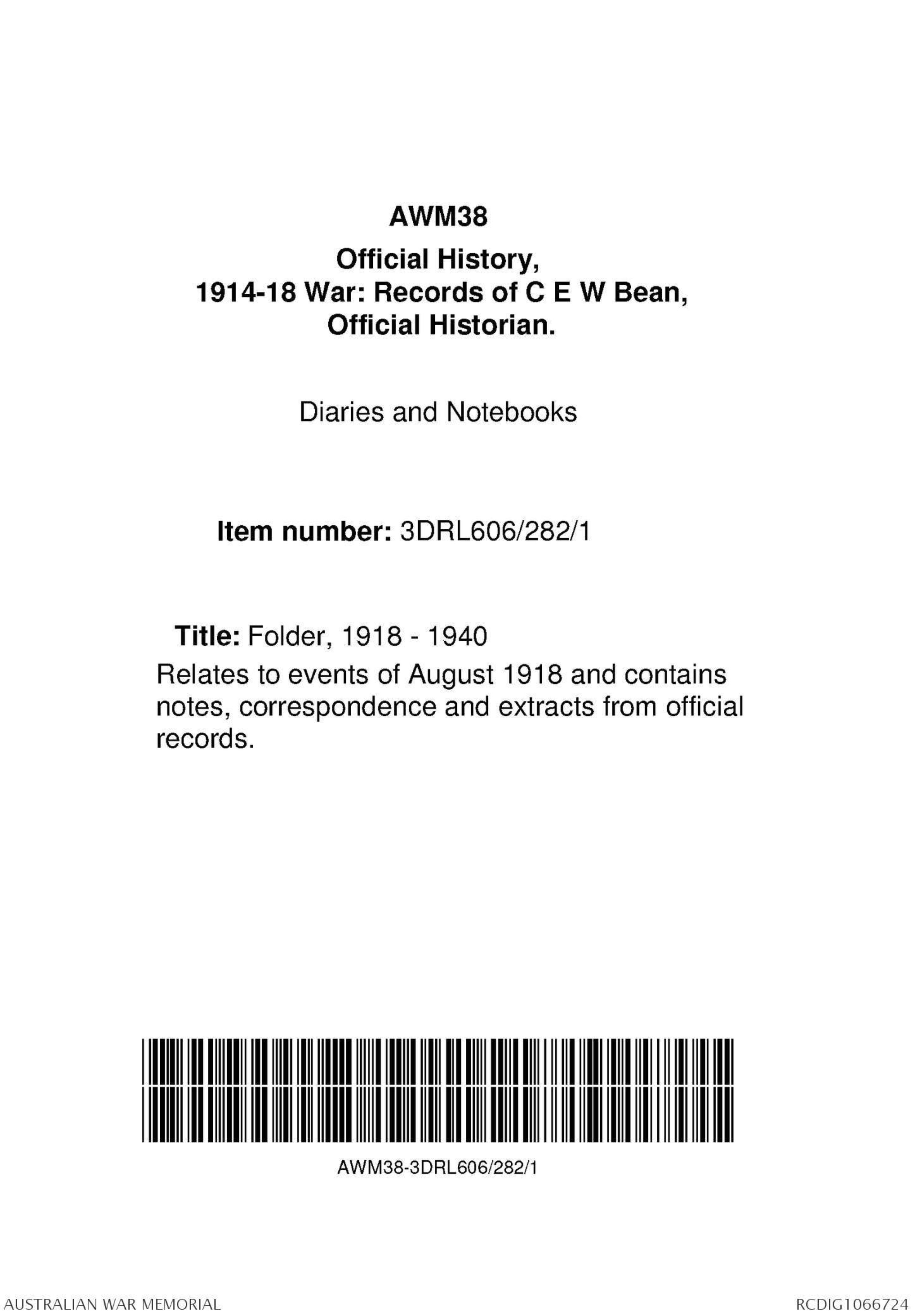
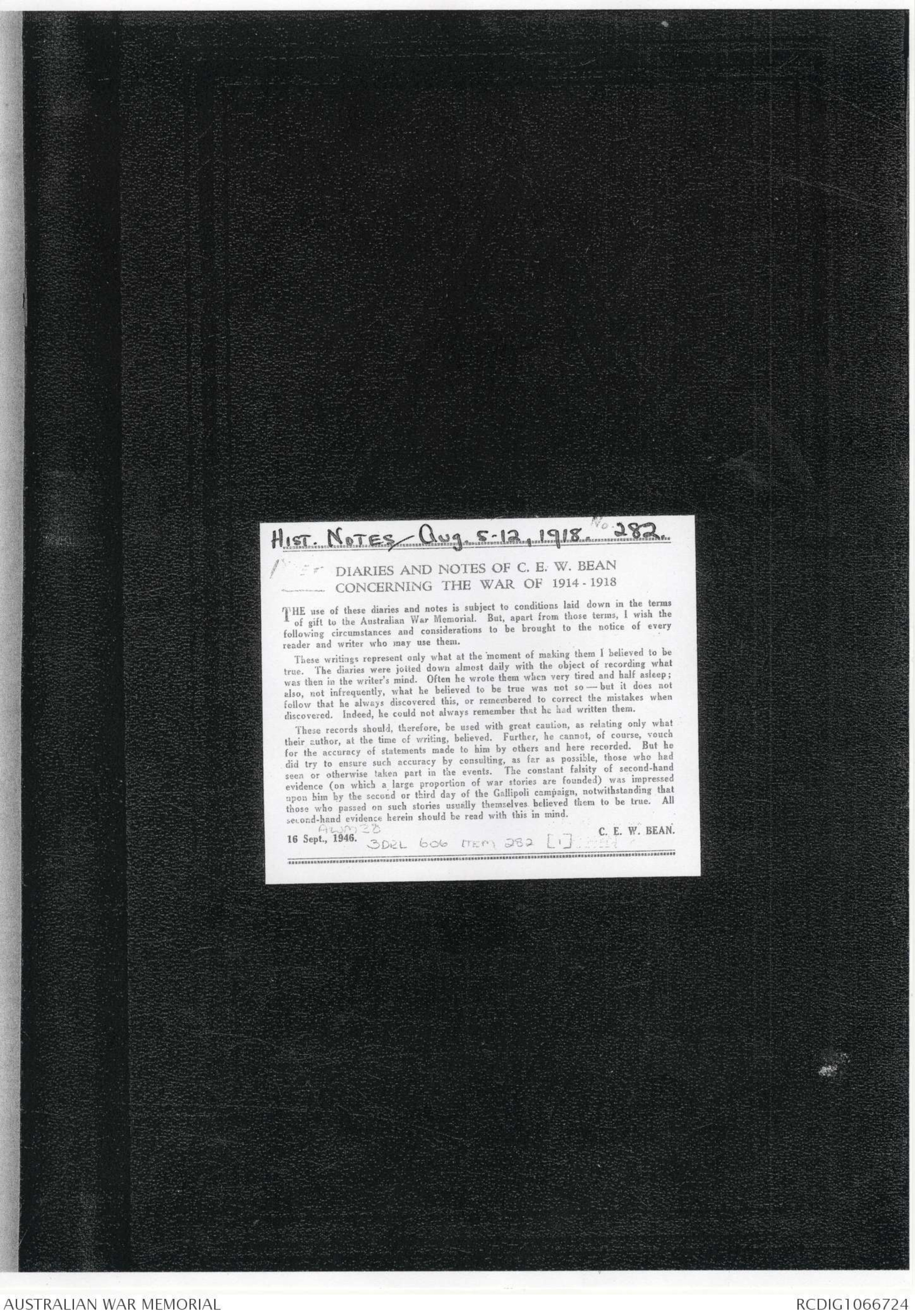
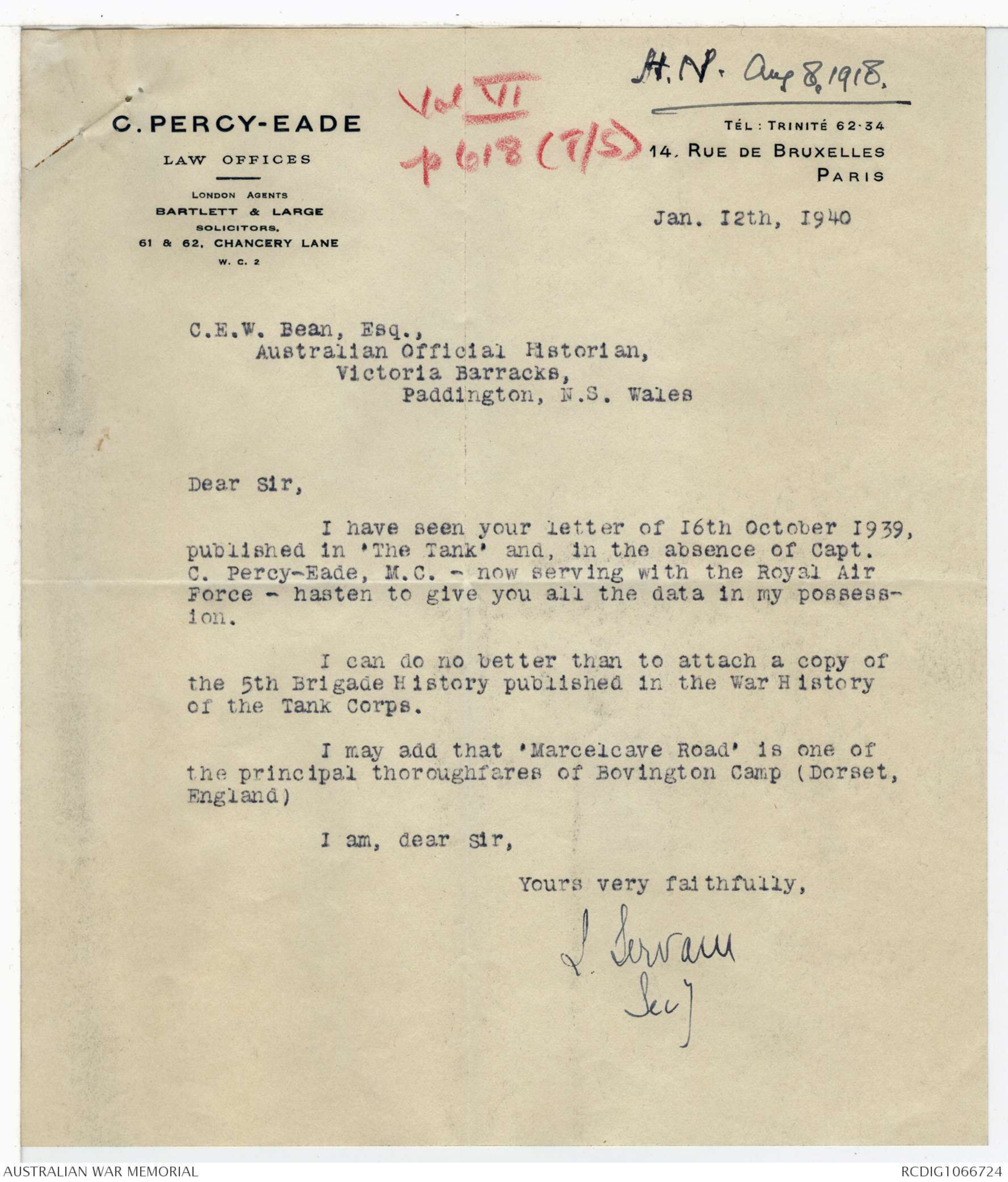
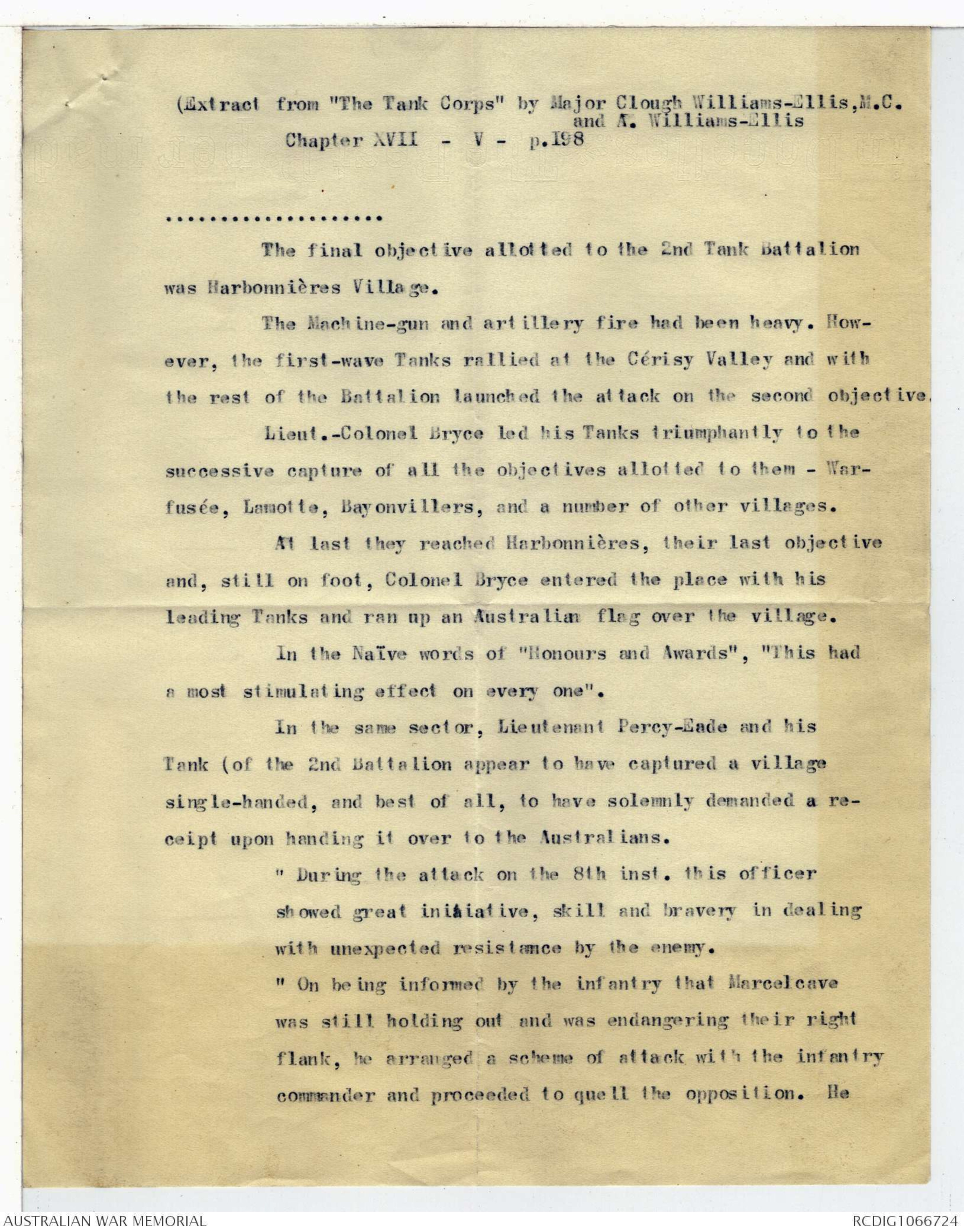

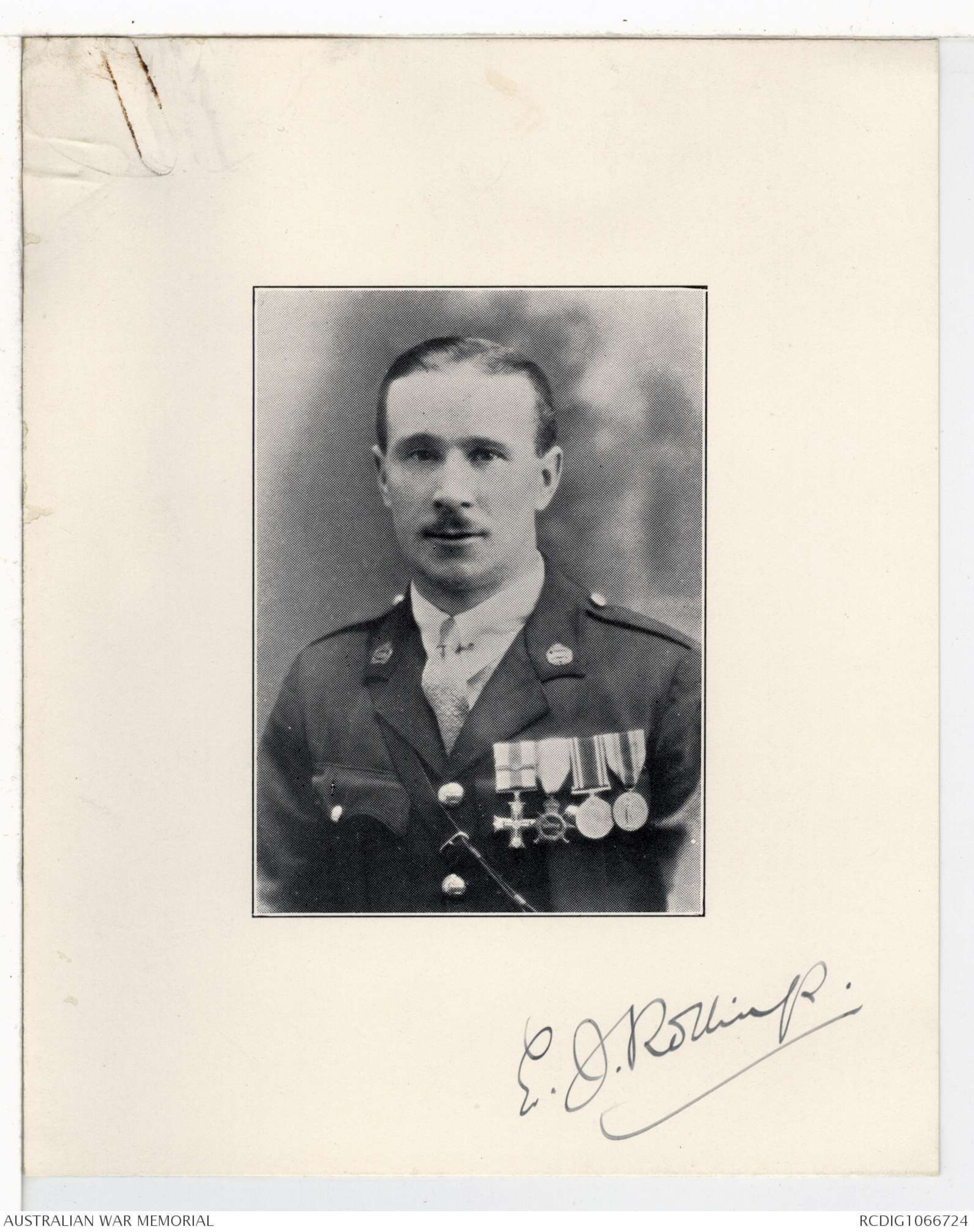
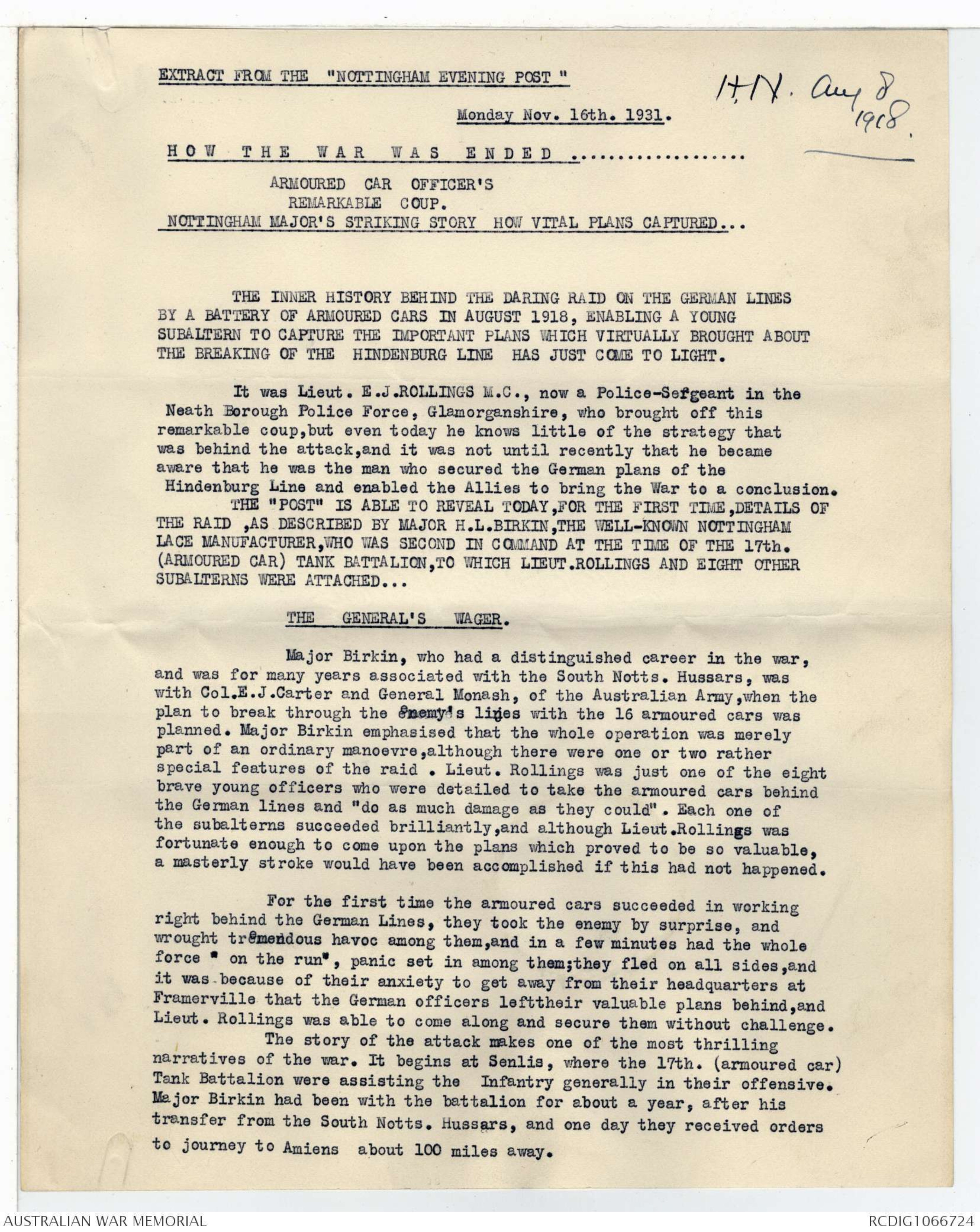
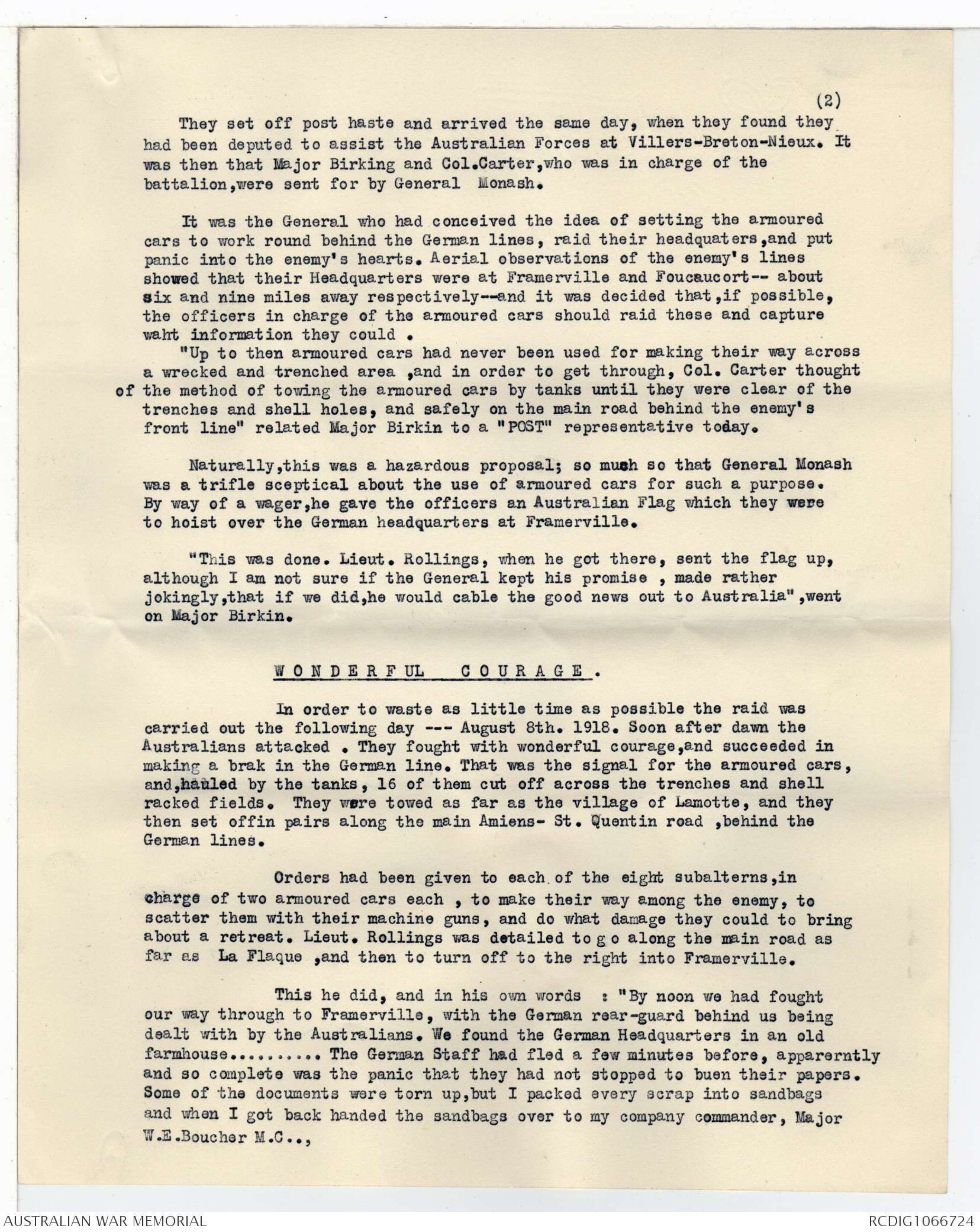
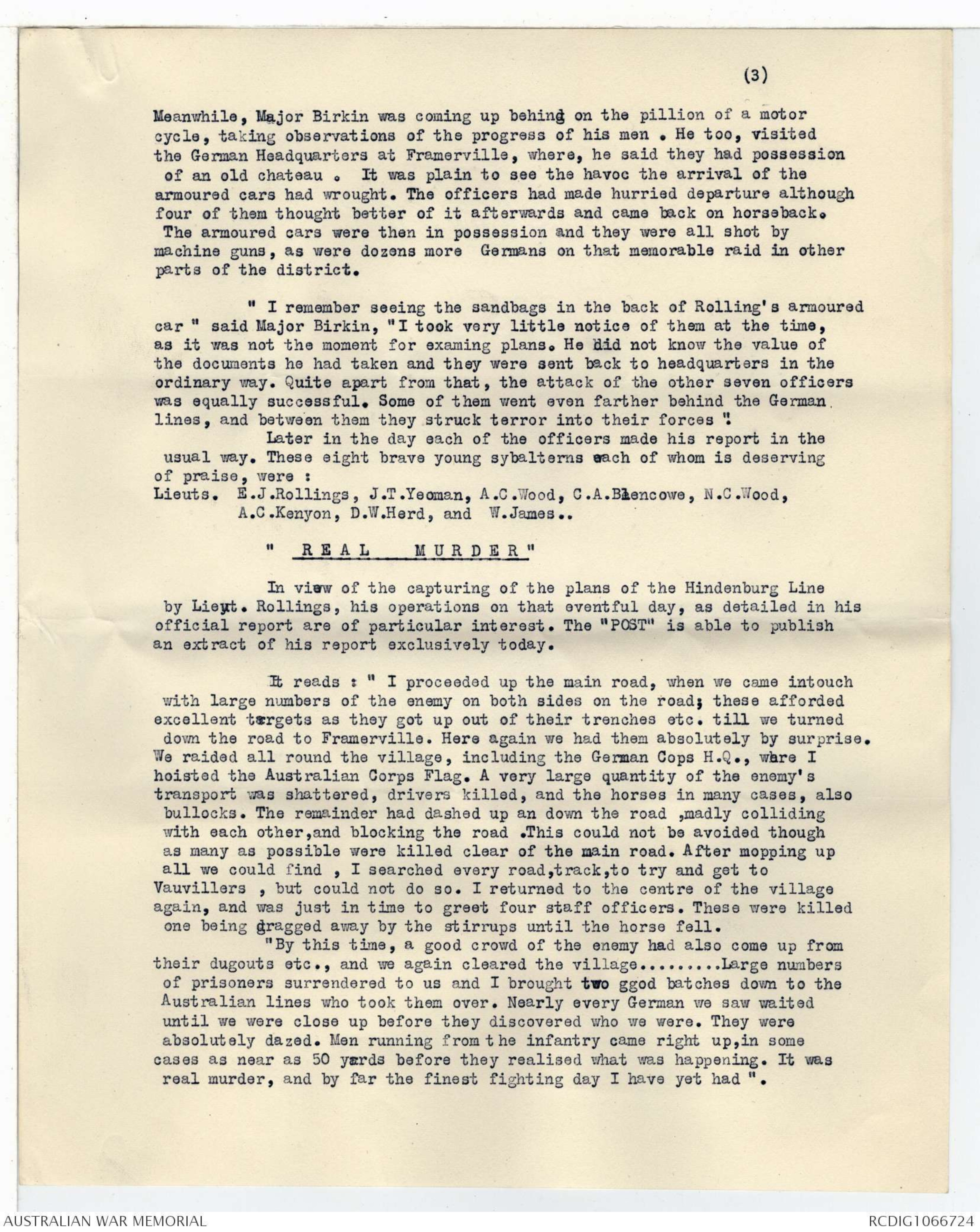
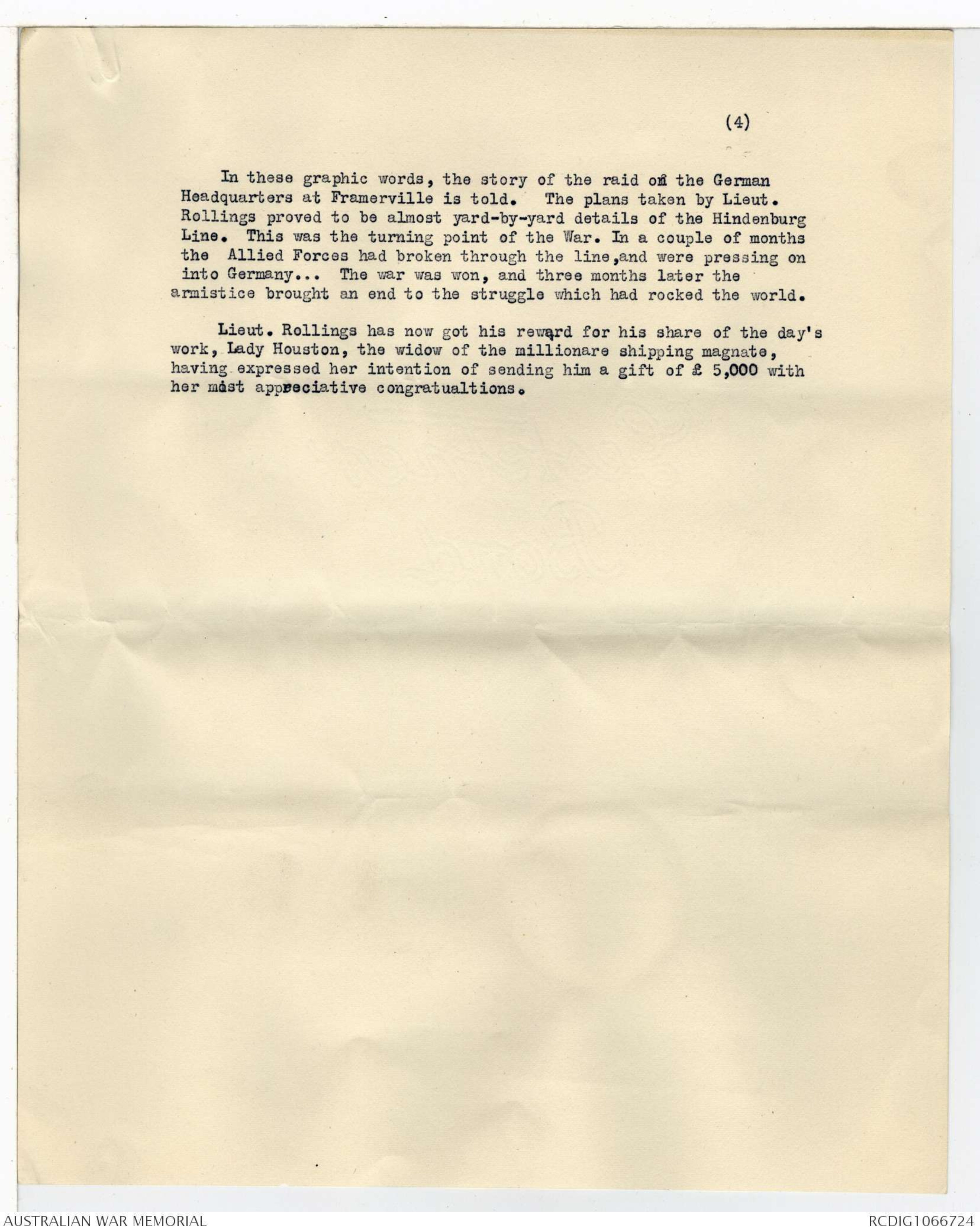
AWM38
Official History,
1914-18 War: Records of C E W Bean,
Official Historian.
Diaries and Notebooks
Item number: 3DRL606/282/1
Title: Folder, 1918 - 1940
Relates to events of August 1918 and contains
notes, correspondence and extracts from official
records
AWM38-3DRL606/282/1
Hist. Notes/ Aug. 5-12, 1918. No 282.
DIARIES AND NOTES OF C. E. W. BEAN
CONCERNING THE WAR OF 1914 - 1918
THE use of these diaries and notes is subject to conditions laid down in the terms
of gift to the Australian War Memorial. But, apart from those terms, I wish the
following circumstances and considerations to be brought to the notice of every
reader and writer who may use them.
These writings represent only what at the moment of making them I believed to be
true. The diaries were jotted down almost daily with the object of recording what
was then in the writer’s mind. Often he wrote them when very tired and half asleep;
also, not infrequently, what he believed to be true was not so — but it does not
follow that he always discovered this, or remembered to correct the mistakes when
discovered. Indeed, he could not always remember that he had written them.
These records should, therefore, be used with great caution, as relating only what
their author, at the time of writing, believed. Further, he cannot, of course, vouch
for the accuracy of statements made to him by others and here recorded. But he
did try to ensure such accuracy by consulting, as far as possible, those who had
seen or otherwise taken part in the events. The constant falsity of second-hand
evidence (on which a large proportion of war stories are founded) was impressed
upon him by the second or third day of the Gallipoli campaign, notwithstanding that those who passed on such stories usually themselves believed them to be true. All second-hand evidence herein should be read with this in mind.
AWM 20
16 Sept., 1946. C. E. W. BEAN.
3DRL 606 ITEM 282 [1]
[* Vol VI
to 618 (7/5)*]
[*H.N. Aug 8, 1918.*]
C. PERCY-EADE
LAW OFFICES
LONDON AGENTS
BARTLETT & LARGE
SOLICITORS,
61 & 62, CHANCERY LANE
W.C. 2
Tel: TRINITE 62-34
14. RUE DE BRUXELLES
PARIS
Jan. 12th, 1940
C.E.W. Bean, Esq.,
Australian Official Historian,
Victoria Barracks,
Paddington, N.S. Wales
Dear Sir,
I have seen your letter of 16th October 1939,
published in 'The Tank' and, in the absence of Capt.
C. Percy-Eade, M.C. - now serving with the Royal Air
Force - hasten to give you all the data in my possession.
I can do no better than to attach a copy of
the 5th Brigade History published in the War History
of the Tank Corps.
I may add that 'Marcelcave Road' is one of
the principal thoroughfares of Bovington Camp (Dorset,
England)
I am, dear sir,
Yours very faithfully,
[[L Servau?]]
Sec
(Extract from "The Tank Corps" by Major Clough Williams-Ellis,M.C.
and A. Williams-Ellis
Chapter XVII - V - p.198
.....................
The final objective allotted to the 2nd Tank Battalion
was Harbonnières Village.
The Machine-gun and artillery fire had been heavy. However,
the first-wave Tanks rallied at the Cérisy Valley and with
the rest of the Battalion launched the attack on the second objective.
Lieut.-Colonel Bryce led his Tanks triumphantly to the
successive capture of all the objectives allotted to them - Warfusée,
Lamotte, Bayonvillers, and a number of other villages.
At last they reached Harbonnières, their last objective
and, still on foot, Colonel Bryce entered the place with his
leading Tanks and ran up an Australian flag over the village.
In the Naive words of "Honours and Awards", "This had
a most stimulating effect on every one".
In the same sector, Lieutenant Percy-Eade and his
Tank (of the 2nd Battalion appear to have captured a village
single-handed, and best of all, to have solemnly demanded a receipt
upon handing it over to the Australians.
" During the attack on the 8th inst. this officer
showed great initiative, skill and bravery in dealing
with unexpected resistance by the enemy.
" On being informed by the infantry that Marcelcave
was still holding out and was endangering their right
flank, he arranged a scheme of attack with the infantry
commander and proceeded to quell the opposition. He
2.
destroyed at least six machine-guns with their crews,
besides taking many prisoners. He then handed over
the village to the infantry, from whom he took a receipt.
After regaining his position and during the second phase
of the attack, he heard opposition coming from Bayonvillers,
so he proceeded towards that village. As he
was approaching it from the south-west, he discovered a
group of three light field guns, two of which were firing
at him at short range. These guns had already
knocked out several Tanks. With great gallantry and
determination he maneuvered his Tank in their direction
and so directed the fire of his own guns that he dispersed
the gunners. After running over one of the field
guns, he proceeded into the village, where his Tank was
directly responsible for capturing at least forty of
the enemy.
"Throughout the whole of the operation, this Tank
Commander set his crew a magnificent example of courage
and determination. (Immediate Reward)"
Portrait - see original document
E.J. ROLLINGS
[*H.N. Aug 8
1918*]
EXTRACT FROM THE "NOTTINGHAM EVENING POST"
Monday Nov. 16th. 1931.
HOW THE WAR WAS ENDED ...................
ARMOURED CAR OFFICER'S
REMARKABLE COUP.
NOTTINGHAM MAJOR'S STRIKING STORY HOW VITAL PLANS CAPTURED...
THE INNER HISTORY BEHIND THE DARING RAID ON THE GERMAN LINES
BY A BATTERY OF ARMOURED CARS IN AUGUST 1918, ENABLING A YOUNG
SUBALTERN TO CAPTURE THE IMPORTANT PLANS WHICH VIRTUALLY BROUGHT ABOUT
THE BREAKING OF THE HINDENBURG LINE HAS JUST COME TO LIGHT.
It was Lieut. E.J.ROLLINGS M.C., now a Police-Sergeant in the
Neath Borough Police Force, Glamorganshire, who brought off this
remarkable coup, but even today he knows little of the strategy that
was behind the attack, and it was not until recently that he became
aware that he was the man who secured the German plans of the
Hindenburg Line and enabled the Allies to bring the War to a conclusion.
THE "POST" IS ABLE TO REVEAL TODAY, FOR THE FIRST TIME, DETAILS OF
THE RAID ,AS DESCRIBED BY MAJOR H.L.BIRKIN,THE WELL-KNOWN NOTTINGHAM
LACE MANUFACTURER,WHO WAS SECOND IN COMMAND AT THE TIME OF THE 17th.
(ARMOURED CAR) TANK BATTALION,TO WHICH LIEUT.ROLLINGS AND EIGHT OTHER
SUBALTERNS WERE ATTACHED...
THE GENERAL'S WAGER.
Major Birkin, who had a distinguished career in the war,
and was for many years associated with the South Notts. Hussars, was
with Col. E.J. Carter and General Monash, of the Australian Army, when the
plan to break through the enemy's lines with the 16 armoured cars was
planned. Major Birkin emphasised that the whole operation was merely
part of an ordinary manoevre ,although there were one or two rather
special features of the raid . Lieut. Rollings was just one of the eight
brave young officers who were detailed to take the armoured cars behind
the German lines and "do as much damage as they could" . Each one of
the subalterns succeeded brilliantly ,and although Lieut.Rollings was
fortunate enough to come upon the plans which proved to be so valuable,
a masterly stroke would have been accomplished if this had not happened.
For the first time the armoured cars succeeded in working
right behind the German Lines, they took the enemy by surprise, and
wrought tremendous havoc among them,and in a few minutes had the whole
force " on the run" , panic set in among them;they fled on all sides,and
it was because of their anxiety to get away from their headquarters at
Framerville that the German officers lefttheir valuable plans behind,and
Lieut. Rollings was able to come along and secure them without challenge.
The story of the attack makes one of the most thrilling
narratives of the war. It begins at Senlis, where the 17th. (armoured car)
Tank Battalion were assisting the Infantry generally in their offensive.
Major Birkin had been with the battalion for about a year, after his
transfer from the South Notts. Hussars, and one day they received orders
to journey to Amiens about 100 miles away.
(2)
They set off post haste and arrived the same day, when they found they
had been deputed to assist the Australian Forces at Villers-Breton-Nieux. It
was then that Major Birking and Col.Carter,who was in charge of the
battalion,were sent for by General Monash.
It was the General who had conceived the idea of setting the armoured
cars to work round behind the German lines, raid their headquaters, and put
panic into the enemy's hearts. Aerial observations of the enemy's lines
showed that their Headquarters were at Framerville and Foucaucort –- about
six and nine miles away respectively--and it was decided that,if possible,
the officers in charge of the armoured cars should raid these and capture
waht information they could .
"Up to then armoured cars had never been used for making their way across
a wrecked and trenched area ,and in order to get through, Col. Carter thought
of the method of towing the armoured cars by tanks until they were clear of the
trenches and shell holes, and safely on the main road behind the enemy's
front line" related Major Birkin to a "POST" representative today.
Naturally,this was a hazardous proposal; so much so that General Monash
was a trifle skeptical about the use of armoured cars for such a purpose.
By way of a wager,he gave the officers an Australian Flag which they were
to hoist over the German headquarters at Framerville.
"This was done. Lieut. Rollings, when he got there, sent the flag up,
although I am not sure if the General kept his promise , made rather
jokingly ,that if we did,he would cable the good news out to Australia" , went
on Major Birkin.
WONDERFUL COURAGE.
In order to waste as little time as possible the raid was
carried out the following day --- August 8th. 1918. Soon after dawn the
Australians attacked . They fought with wonderful courage,and succeeded in
making a brak in the German line. That was the signal for the armoured cars,
and,hauled by the tanks, 16 of them cut off across the trenches and shell
racked fields. They were towed as far as the village of Lamotte, and they
then set offin pairs along the main Amiens- St. Quentin road ,behind the
German lines.
Orders had been given to each of the eight subalterns ,in
charge of two armoured cars each , to make their way among the enemy, to
scatter them with their machine guns, and do what damage they could to bring
about a retreat. Lieut. Rollings was detailed to g o along the main road as
far as La Flaque ,and then to turn off to the right into Framerville.
This he did, and in his own words : "By noon we had fought
our way through to Framerville, with the German rear-guard behind us being
dealt with by the Australians. We found the German Headquarters in an old
farmhouse.......... The German Staff had fled a few minutes before, apparerntly
and so complete was the panic that they had not stopped to burn their papers.
Some of the documents were torn up,but I packed every scrap into sandbags
and when I got back handed the sandbags over to my company commander, Major
W.E. Boucher M.C..,
(3)
Meanwhile, Major Birkin was coming up behind on the pillion of a motor
cycle, taking observations of the progress of his men . He too, visited
the German Headquarters at Framerville, where, he said they had possession
of an old chateau . It was plain to see the havoc the arrival of the
armoured cars had wrought. The officers had made hurried departure although
four of them thought better of it afterwards and came back on horseback.
The armoured cars were then in possession and they were all shot by
machine guns, as were dozens more Germans on that memorable raid in other
parts of the district.
" I remember seeing the sandbags in the back of Rolling's armoured
car " said Major Birkin, "I took very little notice of them at the time,
as it was not the moment for examining plans. He did not know the value of
the documents he had taken and they were sent back to headquarters in the
ordinary way. Quite apart from that, the attack of the other seven officers
was equally successful. Some of them went even farther behind the German
lines, and between them they struck terror into their forces ".
Later in the day each of the officers made his report in the
usual way. These eight brave young sybalterns each of whom is deserving
of praise, were:
Lieuts. E.J.Rollings, J.T.Yeoman, A.C.Wood, C.A.Blencowe, N.C.Wood,
A.C.Kenyon, D.W.Herd, and W.James..
"REAL MURDER"
In view of the capturing of the plans of the Hindenburg Line
by Lieut. Rollings, his operations on that eventful day, as detailed in his
official report are of particular interest. The "POST” is able to publish
an extract of his report exclusively today.
It reads : " I proceeded up the main road, when we came intouch
with large numbers of the enemy on both sides on the road; these afforded
excellent targets as they got up out of their trenches etc. till we turned
down the road to Framerville. Here again we had them absolutely by surprise.
We raided all round the village, including the German Cops H.Q., whre I
hoisted the Australian Corps Flag. A very large quantity of the enemy's
transport was shattered, drivers killed, and the horses in many cases, also
bullocks. The remainder had dashed up an down the road ,madly colliding
with each other,and blocking the road .This could not be avoided though
as many as possible were killed clear of the main road. After mopping up
all we could find , I searched every road,track,to try and get to
Vauvillers , but could not do so. I returned to the centre of the village
again, and was just in time to greet four staff officers. These were killed
one being dragged away by the stirrups until the horse fell.
"By this time, a good crowd of the enemy had also come up from
their dugouts etc., and we again cleared the village..........Large numbers
of prisoners surrendered to us and I brought two ggod batches down to the
Australian lines who took them over. Nearly every German we saw waited
until we were close up before they discovered who we were. They were
absolutely dazed. Men running from the infantry came right up,in some
cases as near as 50 yards before they realised what was happening. It was
real murder, and by far the finest fighting day I have yet had".
(4)
In these graphic words, the story of the raid on the German
Headquarters at Framerville is told. The plans taken by Lieut.
Rollings proved to be almost yard-by-yard details of the Hindenburg
Line. This was the turning point of the War. In a couple of months
the Allied Forces had broken through the line,and were pressing on
into Germany... The war was won, and three months later the
armistice brought an end to the struggle which had rocked the world.
Lieut. Rollings has now got his reward for his share of the day's
work, Lady Houston, the widow of the millionaire shipping magnate,
having expressed her intention of sending him a gift of £ 5,000 with
her most appreciative congratulations.
 Diane Ware
Diane WareThis transcription item is now locked to you for editing. To release the lock either Save your changes or Cancel.
This lock will be automatically released after 60 minutes of inactivity.